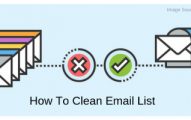
This article gives you tips for using the purchased email list is the safest way, and we’ve also explained the most successful tips for buying an email list.
For B2B companies looking forward to producing more engagement and sales, effective email marketing campaigns can provide a platform for sweet success.
Buying email lists offers a much quicker alternative to slowly building a list over time. However, finding a clean email list that’s and open to your messages can be pretty challenging.
If you’re going to run a thoroughly successful email marketing campaign to a bought email list, it’s crucial to master the basics besides avoid common mistakes.
Fortunately, avoiding these mistakes will be easy if you read this guide, and create an email campaign that hits the target on time will be easy for you.
Before you buy email lists, there is a pinch of questions to answer:
- Does your ESP let you import 3rd party lists?
- Is it entirely legal to email other people without their consent in your target country?
- Do any better ways to grow your business exist, such as building your own lead database?
- Are you sure that the list you bought is relevant for your business? Do you have guarantees that the data in that list is up to date?
Here are the crucial tips your business can utilize to further increase responses from purchased lists.
How to Use Purchased Email Lists With Unbeatable safety
What’s the actual Buying an Email List Mean?
Of course, we all know what buying an email address list actually means.
However, things aren’t as simple as they look.
There’s a vital distinction to draw between the email marketing lists one can rent and the email lists that you can buy.
So, when you buy an email list from someone, you get a file consisting of a list of contacts that you need to email yourself.
When you rent a list, you’re actually sending your email to someone else’s list. In this case, the list owner will send all the emails for you, and you’re never going to figure out who received your email. We can compare that to a situation where you pay for an ad in somebody else’s newsletter.
Then the question of the type of email lists that you’re buying arises. There are some ways to build an email list:
- Use surveys, messages, or phone calls to gather the contact details directly.
- Use sweepstakes and other enticements.
- Scrape emails online (in such case, the company offering the list finds public email addresses by scanning the web.
The majority of the companies selling marketing data won’t clarify how the data is gathered. Here’s a page from a big player in the field, explaining their policies:

See? you’ll feel like you still don’t know how they gathered the data or if you have the right to contact these people on their lists…
That’s certainly why legislators gave importance to defining rules for this sort of activity.
Is it Worth buying B2B Data?
In short, yes. Buying a list of potential leads certainly saves you loads of time in contrast to manual outreach. However, you’ll look forward to finding a reputable data provider to make sure that you get your money’s return.
First off, you’ll desire to buy a list of subscribers who are interested in your business. That means that they have bought products that are identical to yours in the past or work in your industry.
Purchasing an email list of low-level business owners interested in digital marketing when you provide legal services to corporations doesn’t result in big conversions.
Without relevancy, subscribers are pretty much likely to unsubscribe. So, don’t waste your budget on a list consisting of cold subscribers who aren’t interested in working with you or buy your products/service.
After mentioning all that, it’s worth it to purchase B2B data in case you anticipate a return on your invested money. Now, it’s a matter of discovering an email list provider that’s worth your trust.
One secret to Email Success:
One big myth is that you require tens of thousands of email addresses in order for email success. However, the truth of the matter says that you require quality email addresses rather than quantity. FACT: 5,000 properly targeted quality email addresses are going to generate more responses in comparison to a hundred thousand low-quality email addresses.
Tips to Purchase the best email list possible
If you have already bought, and it doesn’t meet the following considerations, then straightaway go for money back!
So, when you feel that purchasing a list will do good to you, we recommend that you do the following:
1) Properly figure out who you’re targeting
Now, here’s a brief rundown explaining how you identify that ideal customer:
- Firstly, rank your clients by most profitable, best revenue, and unchallenged with which to do business.
- Then rank by least profitable, least revenue, and toughest with which to do business.
- Now, estimate up the characteristics of your top five companies on each list.
- Figure out what characteristics link the best to the worst?
This info is exactly what you need to paint a clear picture of your ideal customer. Now, take this process to the further step and note the following:
- Annual revenue and geographic reach
- Number of employees
- Industry vertical, including normal keywords that identify the companies and SIC (Standard Industrial Classification) and NAICS (North American Industrial Classification)
- Decision-maker roles
- Psychographics such as culture, values, and internal & external issues that impact their buying decisions
Don’t invest in a list without this basic information.
2. Find a consultative list provider
List sellers can be pretty pushy; look for one who’s rewarded by how properly he serves instead of how much he sells. While looking at email list providers:
- Be clear that you are purchasing a list and not renting. Several companies only rent lists. Hence, you can use them just for a given period or number of times. That certainly doesn’t work that well for an ongoing demand generation.
- Ensure it includes the perfect demographic data to reach your ideal audience.
- Find out whether they can create lists by both SIC code and keyword, and whether they can identify contacts who all have bought services/products that are similar to yours or not.
3) Invest in the best rather than the cheapest
Our team tested deeply and found that the cheapest email list actually proves to be 50% more costly in contrast to the most expensive one. How silly does that sound?
Well, here’s the story in a nutshell:
Our director’s friend’s company is doing lead generation for a huge billion-dollar telecommunications company.
Our teams compared the cheapest email list (names gathered from business cards) with the most expensive lists, where data was contrasted against numerous sources, and names, roles, and titles were each verified with a direct phone call.
Further, our teams made 414 phone calls with the same staff, and they used an identical script. They called at the exact same time of day. They compared the number of calls to:
- Disqualify a contact – With the most costly list, it took 122 calls, while with the least expensive, it just took 17.
- Attain a lead – With the most expensive list. It took only 74 calls to attain a sales-ready lead, while it took 255 with the least.
- With the cheap list, 69% of the people present on the list were actually no longer with the company!
After an entire month of calling, our experiments revealed the expense per lead with the most costly list was $412; the cost per lead while the cheapest list was $659.
4) Test your lists no matter they’re internal
Call around 300 contacts to figure out if:
- Review to see whether there are duplicate data
- Check-in case the information is fresh, current, and complete
- Confirm the contacts are within your target market.
In case more than one in 20 fails, you need to understand that the list definitely requires a good cleaning before you use it.
“Brands Enhance Lead Generation Strategies” is a Direct Marketing News article, where Director of Marketing at Boardroom (a direct response publishing company Inc.), Michael Feldstein, exclaims he is “never sure” in case the list he has purchased is current and accurate.
He further explains, “That’s why we always test,” “In case we have 50,000 names, we certainly test 5,000.” He continues by saying that he does his best to purchase names from trustworthy companies that won’t preload the email/contact test with good names.
5) Appoint one person as the listed expert
You can have the ultimate best campaign, but in case your list is rubbish, it certainly won’t get the results it deserves. We’ve found that at least 50% of the success of an outbound campaign depends on list quality. That’s the reason you need to appoint at least one dedicated person to monitor, updating and most importantly, maintaining your lists.
6) Business Email list – Generic Email Addresses
If you send your offer to email addresses such as “[email protected],” it will result in few responses. Explaining further, Generic email addresses are pretty common with attorney email lists, restaurant email lists, and various other business email list sellers.
These sorts of email addresses indicate that the email addresses were assembled from web crawlers. For a fortunate and fruitful email list campaign, you require the email address of the restaurant/ partner/owner, and not info.
7) 90+% delivery rate is extremely important
Why is your email response rate so low? The ISPs (Yahoo, Gmail, etc.) will block “good-deliverable” email addresses. In other cases, they’ll divert to the SPAM box in case the “good” email addresses are linked with an email blast that possesses a number of bad email addresses.
Such blocking of good email addresses is the reason why an email blast to a million names can literally have absolutely zero responses.
Using an email list that’s less than 90 percent deliverable will further result in your adequate email addresses being blocked. That will make the email campaign futile. You should demand a 90+% email delivery rate or direct “money refund.”
8) More Free names or straightaway money refund
To compensate for undeliverable emails, a few list sellers will promise to happily send you FREE email addresses.
Now, the weakness of such a refund type is that more FREE emails certainly won’t correct the fact that the majority of the good email addresses were either blocked or diverted straightaway to the SPAM box, because the email list is over 10% bad.
Bottom-line, we advise you to avoid buying email lists that don’t offer a “money refund” guarantee. You’ll receive a huge quality email list when there’s a money refund guarantee backing your purchase.
9) Request Complete Name of direct mail addresses and Email Recipient
Ask that the email list comes with the email recipient’s “full contact name” and the “direct mail address.” Move further with caution when you find an email list is missing this key data.
Besides that, ensure the direct mail addresses have over 90 percent delivery guarantee or straightaway money refund as we mentioned above. Having an email recipient’s full name will let you know whether you’re receiving numerous email addresses for the same person.
Besides that, the direct mail address will acknowledge you if you’re getting 5 email addresses for the same household. That could definitely raise a flag in case you were seeking only the adult male parent and not all the children.
You’re simply shooting in the dark without the email recipient’s “full name” and direct mail address. You absolutely have no idea regarding the email list’s names that you just bought.
10) Value of time
Only $99 for a hundred thousand email addresses. Undoubtedly, some email lists are so low-priced that there isn’t much money risk in giving a hit.
However, the hassle and time in dealing with such a low-quality email list certainly adds up a lot of money, doesn’t it? The risk of your IP address getting blacklisted also stands tall for using such a low-quality email list. Besides that, there’s the potential risk/damage to your company/brand name.
11) Really getting the list, you requested
Is this truly an affluent email list? Is this truly an email list of seniors? One method to verify your email list is that you can use a basic Demographic Enhancement Report.
There are a few services available (paid/free) for whom you need to send a random sample of your list, and they’ll provide you with a fully detailed Demographic Report, which will show the income, gender, net worth, age, and other demographic profile.
Undoubtedly various analytical vendors provide the same report but do your research if you opt for the paid service.
But what if I’ve already bought a list without considering the focal points?
If you’ve already bought a readymade email list, then we aren’t scaring you, but you haven’t done that good thing. Some furious side effects may wait for you like:
- The emails may not consist targeted audience
- The accuracy and success percentage of your campaign may be much less than expectations
- You are likely violating various terms of service
- Reduction of email deliverability
- It can act as a morale killer
But no worries, we’ll pull you out of such situations!
Now, when you are already standing holding a dangerous and risky email list in your hand, there’s a superb solution that will certainly stop the tears from rolling down your cheeks.
It’s none other than an email verification tool that proves to be a boon in such a situation. Yes, you need to depend on the paid ones if you really want to be on the safer side.
A few email verification tools cost really high, but we won’t let you burn your legs in hot water at all! We’ve tested everything, and that’s how we are so confident with our recommended solution here.
The top recommendation is, tap Myemailverifier.com and there you get tremendous email verification service at exceptionally low rates. Naah, no need to worry, as you’re getting free credits, and there are no words to explain how well does this service support those who’ve already invested in buying email lists rather than building them manually.
Why My Email verifier over any other service?
Explaining honestly, we recommend My Email verifier over any other service because this particular service has pulled many email list buyers out of huge troubles. Email verification solves tons of issues, but services like this one take care of a number of perspectives, which several others don’t!
So, how does this service assist you?
The functioning of this service is in no way tough to understand. Just drop your email list, and it will take some time to verify your email list (It takes 177 mins to verify 10k emails).
Once the process is completed, the reality will be right in front of you. You’ll get all rubbish email ids separated from the rest of the list, and with that, all potential issues like decreased deliverability, getting blacklisted, etc., get eliminated.
Aren’t you feeling light after hearing that?
In our 2021 testing, MyEmailVerifier verified 96% of emails accurately, and that’s more than enough to pull you to the safer side. So, worries shouldn’t exist!
The expert’s advice!
It has worked out exceptionally well for a number of businesses and organizations, and the same can work out for you as well. You’ve already invested money in buying email lists, which is undoubtedly risky, and now, you shouldn’t hesitate to spend a bit when it comes to the safety and consolidating the success of your email marketing campaign.
knowledge junction
Is It Legal to purchase or Rent an Email List?
At first, sight, Buying email lists appears simple.
A quick Google search reflects a lot of promising results. But this certainly doesn’t mean it’s legal. We need to review what the law has to say in North America and Europe. Shall we move further?
The Rules in Europe
To understand what’s permitted with European citizens, we reviewed an interview of Emilie de Vaucresson from EDV Avocats, a huge IP/IT law firm based in Paris.
In that interview, Emilie exclaimed that EU law imposes pretty strict rules on email marketing. The reason is that it has to follow two pieces of legislation:
- ePrivacy directive is the first one. As the name follows, the individual’s email usage for purposes of direct marketing is lawful only in the case that the individual offered his/her prior consent.
- Now, the GDPR is the second one. This name describes that the consent should be valid. It requires to be freely provided, certain, unambiguous & informed.
A single stipulation for a consent to be perfect makes it particularly hard for the email address databases that are to be lawfully used for purposes such as direct marketing: the requirement concerning vital information.
In order for your email database to be allowed/activated by the email marketer who has bought it, the people who consented to get marketing emails surely would have been informed right at the time when their consent was provided – that this specific email marketer would forward them direct marketing emails.
Talking about practice, this isn’t likely to occur: email list sellers typically concentrate on achieving an individual’s consent to get marketing emails directly, and after that, they think about selling the list.
Furthermore…
To compile a valid and legal list that can be allowed/activated lawfully by the customer buying the list, the email list seller must be having knowledge regarding who he was selling it to before he compiled the list. Doing this will severely limit the seller’s agility for compiling lists that he wants to sell, as it limits every single list to one certain purchaser!
Besides that, EU law is not as tough on the renting email databases process as it is on purchasing them.
When an organization rents an email address list, it never has address access to which its emails are forwarded. The owner of the list does all the operations of direct marketing using his own name and is the one and only one who has to comply with GDPR obligations and ePrivacy.
The list owner still must achieve individuals’ major consent on which they want to use their email addresses for the third party’s promotion of their services and products, but it doesn’t have to know the third party for whom it will forward direct marketing emails at the specified time periods the consents are gathered.
After all, renting an email database is currently the only option that’s legally viable for marketers that are in the EU.
The Rules in the United States
To gather knowledge regarding what is acceptable in the North American zone, we talked with Travis, who is a lawyer and works in the compliance department of the prominent American bank, and obviously, he wanted to remain anonymous.
Here’s what that lawyer told us regarding what’s legal in the US.
The rules that are valid to commercial emails were described in the year 2003 in the CAN-SPAM act.
The law makes it possible to purchase or rent email lists, as it doesn’t need you to get the consent of your recipient before you contact them.
However, for your emails to comply with the law, you must observe the following rules:
- Never use false or misleading information in your email’s header
- Incorporate an opt-out mechanism as well as honor opt-out requests promptly
- Never use subject lines that are deceptive
- Incorporate your physical postal address
- Gather knowledge about the message as an advertisement
One of the major risks, if you’re renting or purchasing an email list, is to contact people who’ve recently asked to be eliminated from your list. Most importantly, to avoid that pitfall, ensure excluding all the individuals who have opted out from the communications.
The Rules in Canada
When it comes to email lists, Canada maintains one of the strictest rules. The Canada Anti Spam Law set accurate rules for commercial messages.
The first one states that citizens must provide their consent (which is a must) before you can email them. You can only contact people who’ve provided their explicit consent to be contacted. In some cases, you can send emails to people who are already having an existing business relationship with you.
Undoubtedly, if you’re purchasing an email list, you’re not observing or following these requirements. Hence, buying email lists that include Canadian residents is illegal.
On the other hand, Renting an email list can be OK in case the provider gathers consent in an appropriate way.
The Conclusion
So, walking together with all those considerations, you can conveniently buy email lists (no matter what the world says that it’s dangerous) and be successful, just by applying the right techniques.
The truth is, without a dependable email verifications service, you cannot expect your email marketing campaign to kiss success, and most importantly, it doesn’t make a hole in your pocket. So, what are you waiting for?
We’ve done our job of doing all experiments and bringing you the best email verifier service – My Email Verifier, and now, it’s your job to verify your lists!


